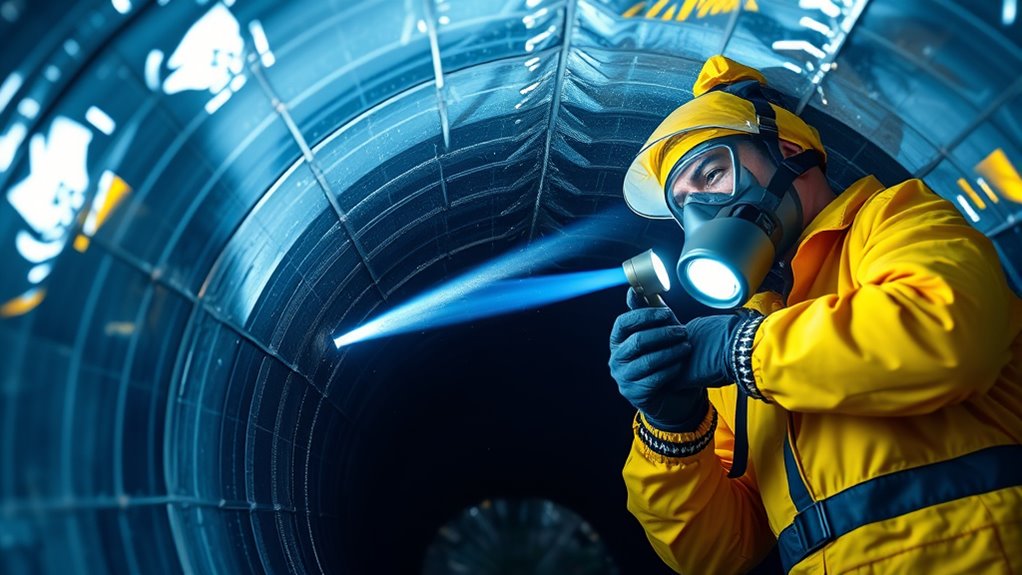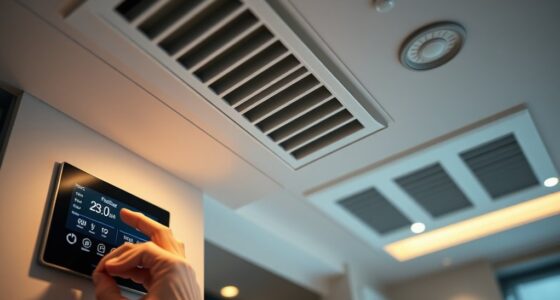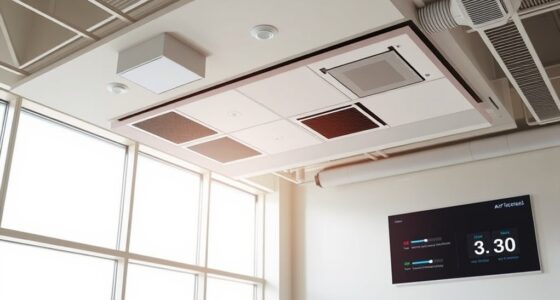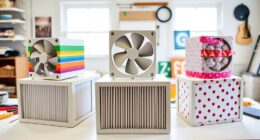Before installing an air purification system, it’s crucial to thoroughly inspect and clean your ducts. This step guarantees your indoor air quality remains high and prevents debris, dust, or mold from interfering with system performance. Proper cleaning also reduces long-term maintenance costs and extends the lifespan of your equipment. Following established cleanliness standards helps you achieve maximum airflow and system efficiency. Continue exploring how proper duct care sets a strong foundation for a healthier indoor environment.
Key Takeaways
- Conduct thorough duct inspections to identify debris, dust, or mold before installing air purification systems.
- Ensure ducts meet established cleanliness standards to optimize air quality and system performance.
- Detect and address any damage or buildup that could impair airflow or cause contamination issues.
- Properly cleaned ducts enhance the effectiveness and lifespan of air purifiers and HVAC components.
- Regular maintenance after installation supports ongoing indoor air quality and system efficiency.

Ensuring duct cleanliness during commissioning is essential to maintain indoor air quality and system efficiency. As you prepare to install an air purification system, it’s crucial to thoroughly inspect your ducts to identify any accumulated debris, dust, or mold. A comprehensive duct inspection allows you to verify that the system is free of contaminants that could compromise air quality or hinder the performance of the purification units. During this process, you should look for signs of buildup or damage that might require targeted cleaning or repairs. This step not only guarantees that the ducts meet established cleanliness standards but also helps prevent future issues, such as mold growth or airflow restrictions, which can negatively impact system operation.
Adhering to cleanliness standards during the commissioning phase is vital because these guidelines set the benchmark for acceptable levels of cleanliness within the ductwork. You want to be sure that the ducts are free from dirt, debris, and other pollutants before proceeding with installation. This is especially important if your system is intended to improve air quality, as contaminants present during installation can quickly become dispersed throughout the indoor environment. To meet these standards, consider employing professional cleaning services that use appropriate tools and methods, such as HEPA vacuuming or agitation techniques, to remove stubborn dust and contaminants. Ensuring that your ducts meet these standards before installing the air purification system guarantees optimal performance and longevity of both the ductwork and the purification devices.
Taking the time to conduct a thorough duct inspection during commissioning might seem like an extra step, but it pays off by reducing long-term maintenance costs and enhancing indoor air quality. Remember, unclean ducts can harbor allergens, bacteria, and mold spores, which can be circulated throughout your space if not properly addressed. By verifying that the ducts are clean and within cleanliness standards, you set a solid foundation for the air purification system to operate effectively. This proactive approach minimizes the risk of future contamination issues and ensures that your indoor environment remains healthy and comfortable. Overall, a diligent focus on duct inspection and cleanliness standards during commissioning is an investment that promotes better air quality, system efficiency, and peace of mind for everyone in the space.
Additionally, implementing proper air purifier maintenance dos and don’ts, such as regular filter checks and cleaning, can further support the effectiveness of your system over time.
Frequently Asked Questions
How Often Should Duct Cleaning Be Performed Before Installation?
You should perform duct cleaning before installation at least once every 3 to 5 years, depending on your maintenance schedule and environmental factors. If your space experiences high dust, pet dander, or mold, increase the cleaning frequency to guarantee ideal air quality. Regular maintenance helps prevent contaminants from affecting your air purification system’s efficiency, so stay proactive and schedule duct cleaning accordingly to keep your system running smoothly.
What Are Signs of Duct Contamination Prior to Cleaning?
You notice duct mold or dust buildup, which are clear signs of contamination. If you see visible mold spots or layers of dust around vents or filters, it indicates your ducts have accumulated debris. These signs often coincide with musty odors or increased allergy symptoms, highlighting the need for thorough cleaning. Addressing duct mold and dust buildup before installing air purification ensures ideal air quality and system efficiency.
Are There Specific Industry Standards for Duct Cleanliness?
Yes, industry standards for duct cleanliness exist, such as those from the NADCA (National Air Duct Cleaners Association). They specify cleaning based on duct material and usage, recommending cleaning frequency to maintain ideal air quality. You should follow these standards, especially if your duct system has a history of contamination or uses specific materials that trap debris. Regular inspections and cleaning help guarantee your system operates efficiently and maintains healthy indoor air.
Can Duct Cleaning Impact Air Quality During Installation?
Did you know that unclean ducts can harbor up to 40 times more dust and contaminants than the air outside? Cleaning your ducts before installing air purification greatly boosts air quality and prevents contamination. By proactively addressing duct cleanliness during installation, you reduce airborne pollutants, ensuring healthier indoor air. This step is essential for ongoing contamination prevention and creates a safer, cleaner environment for everyone inside.
What Tools Are Used for Effective Duct Cleaning?
You use inspection tools like cameras and mirrors to identify dirt buildup inside ducts, ensuring thorough cleaning. For cleaning equipment, you rely on high-powered vacuums, rotary brushes, and compressed air tools to loosen and remove debris effectively. These tools help you reach all duct areas, ensuring they’re spotless before installing air purification systems, which improves overall air quality and system efficiency. Proper use of inspection and cleaning tools is essential for ideal results.
Conclusion
Before installing air purification, commissioning duct cleanliness is vital to guarantee ideal indoor air quality. Imagine, over 60% of indoor air pollutants originate from unclean ducts, quietly affecting your health. By thoroughly cleaning your ducts beforehand, you reduce airborne contaminants and improve system efficiency. Don’t overlook this essential step—taking action now can lead to fresher, healthier air in your space, making every breath you take safer and more comfortable.









